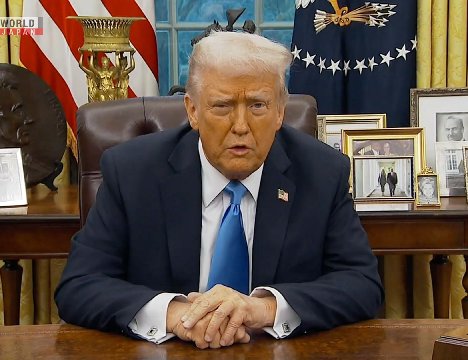
On April 2, 2025, U.S. President Donald Trump declared a "Liberation Day" by imposing sweeping tariffs—a 10% baseline levy on all imports and "reciprocal" tariffs exceeding 50% on key trading partners like China (34%), the EU (20%), and India (26%). While Nepal faces a lower 10% baseline tariff, the ripple effects of this protectionist shift threaten to destabilise its fragile economy, which relies heavily on remittances, tourism, and cross-border trade with India and China. This essay examines the geopolitical and economic ramifications of Trump’s policies for Nepal, emphasising pathways for resilience in a fragmenting global order.
The Tariff Plan: Mechanics and Nepal’s Position
Trump’s two-tiered tariff regime includes:
1 A universal 10% tax on all imports, effective April 5.
2 Reciprocal tariffs on 60 nations, calculated as half the rate the U.S. claims these countries impose on American goods .
Nepal’s Tariff Exposure:
Nepal faces a 10% baseline tariff on exports to the U.S., as the White House claims Nepal imposes a 10% average duty on U.S. goods . While this rate is lower than those applied to India (26%) or Bangladesh (37%), Nepal’s niche exports—such as hand-knotted carpets, pashmina, and garments—could still suffer reduced competitiveness in the U.S. market, which accounted for $112 million in exports in 2024 .
Key Vulnerabilities:
- Remittances: Over 28% of Nepal’s GDP comes from remittances, largely from Gulf nations. If U.S. energy tariffs pressure Gulf economies to curtail hiring, Nepal’s remittance inflows could decline sharply .
- Import Inflation: Nepal sources 65% of its goods from India and China. Tariff-driven supply chain disruptions could raise prices for essentials like fuel, medicine, and machinery .
- Tourism: A global recession triggered by trade wars may reduce foreign tourist arrivals, which rebounded to 1.2 million in 2024 post-pandemic .
Global Reactions and Nepal’s Strategic Dilemma
Retaliatory Measures: Major economies like the EU, China, and Canada have pledged counter-tariffs, risking a $900 billion drop in global trade by 2025. Nepal, however, lacks the economic heft to retaliate and must navigate this turbulence through diplomacy and regional alliances.
Institutional Erosion: The WTO warned that Trump’s policies violate global trade rules, but U.S. dominance limits the body’s enforcement power. For Nepal, this underscores the urgency of diversifying beyond Western-centric frameworks.
Nepal in the Crosshairs: Sectoral Impacts
1 Textiles and Carpets:
- The U.S. is Nepal’s third-largest carpet buyer ($48 million in 2024). A 10% tariff could force Nepali exporters to absorb costs or lose market share to Pakistani and Iranian rivals .
- Opportunity: Leverage Nepal’s "ethical manufacturing" branding to appeal to conscious consumers in Europe and Asia .
2 Agriculture:
- Tariffs on Indian exports (e.g., rice, machinery) may disrupt Nepal’s supply chains, raising input costs for farmers.
- Mitigation: Accelerate partnerships with Bangladesh under BBIN (Bangladesh-Bhutan-India-Nepal) to access alternative markets .
- Hydropower and Energy:
- U.S. tariffs on Chinese solar panels could delay Nepal’s renewable energy projects, which rely on Chinese technology.
- Solution: Collaborate with India under the South Asian Association for Regional Cooperation (SAARC) to fund cross-border energy grids .
Multipolarity in Action: Pathways for Nepal
2 Strengthen Regional Integration
- SAARC and BIMSTEC: Advocate for tariff harmonisation and fast-tracked transit agreements to reduce dependency on India-China trade routes .
- BBIN Motor Vehicle Agreement: Operationalise this pact to boost intra-regional trade, currently a meagre 6% of Nepal’s GDP .
- Diversify Export Markets
- Target Non-Traditional Partners: Expand trade with ASEAN nations via air cargo corridors for niche products like tea and medicinal herbs.
- Digital Commerce: Invest in e-commerce platforms like Sastodeal to bypass traditional supply chains and reach global consumers directly.
4 Leverage Climate Diplomacy
- At COP29, negotiate green technology transfers and carbon credit mechanisms to offset tariff losses. Nepal’s hydropower potential (72 GW untapped) could attract EU and Gulf investments .
5 Currency and Remittance Resilience
- Rupee-Ruble Trade: Explore bilateral agreements with Russia to facilitate remittances from Nepali workers in CIS countries.
- Digital Wallets: Partner with India’s UPI and China’s Alipay to reduce transaction costs for migrant workers .
6 Advocate in Multilateral Forums
- Join African and Latin American blocs in demanding WTO reforms to protect least-developed countries (LDCs) from unilateral tariffs .
Case Study: Nepal’s Carpet Industry
Nepal’s carpet sector employs over 1.2 million workers, mostly women. A 10% U.S. tariff could erase $5 million in annual profits, jeopardizing livelihoods. To adapt:
- Shift to Premium Markets: Target EU luxury buyers by certifying carpets as “child-labor-free” and eco-friendly.
- Domestic Innovation: Use AI-driven looms to reduce production costs by 15% .
Crisis as Catalyst for Self-Reliance
Trump’s tariffs are a wake-up call for Nepal to reduce dependency on volatile global markets and embrace its role in a multipolar Asia. By prioritising regional integration, digital sovereignty, and climate-smart trade, Nepal can transform this challenge into an opportunity for equitable growth. As the adage goes, “Aama le bhane jasto garne, aaphno lagi garne” (Act in your own interest, as your mother advises).
*Zakir Kibria is a writer and nicotine fugitive. Entrepreneur |Policy Analyst|
Chronicler of Entropy | Cognitive Dissident. “Empires decay. Pragmatism
survives. Stay sarcastic.” Email: zk@krishikaaj.com
References
“Multimedia:
- Al Jazeera Documentary (2025). The New Silk Roads: Nepal’s Crossroads.
- Podcast: The Kathmandu Post’s “Trade Winds: Nepal in a Tariff War.”
You may add the following:
1 For a deep dive into Nepal’s geopolitical balancing: documentaries with analyses of China’s Belt and Road Initiative (BRI) and its impacts on South Asia. USilk (2019): http://english.scio.gov.cn/beltandroad/2019-01/31/content_74429431.htm
2 Reference to the podcast is a mistake. Here is the verified link to The Kathmandu Post’s 2024 analysis on trade deficits. “Economic Management Deficit” Link: https://kathmandupost.com/columns/2024/12/03/economic-management-deficit
Further Reading
- Reports:
- Nepal’s Trade Vulnerability Index 2025 (South Asia Watch on Trade, Economics & Environment).
- Hydropower and Geopolitics in the Himalayas (International Centre for Integrated Mountain Development).
- Multimedia:
- Al Jazeera Documentary (2025). The New Silk Roads: Nepal’s Crossroads.
- Podcast: The Kathmandu Post’s “Trade Winds: Nepal in a Tariff War.”
- Rivers as Narratives of Peace in South Asia
- May 18, 2025
- The Snow Leopard’s Shadow: Peter Matthiessen’s Himalayan Odyssey Between Grief and Espionage
- May 12, 2025
- The Kashmir Attack And The Invisible Hand Of Imperial Strategy
- May 07, 2025
- South Asia’s Dysfunction Derby: A Love Letter (and Roast) from Dhaka to Kathmandu
- May 03, 2025
- The Silent Crossings: A Nepali Elegy for the Lost Souls of Fortress Europe
- Apr 19, 2025
















